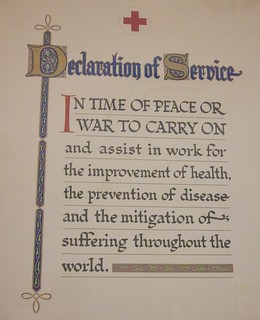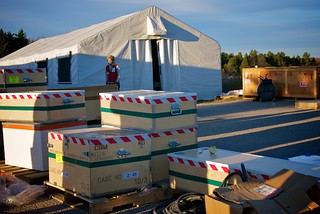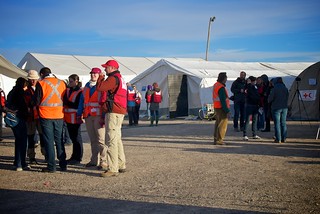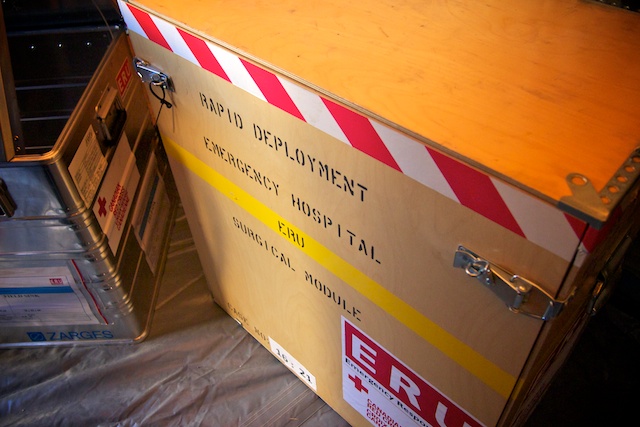Canadian Red Cross Emergency Response Unit
Last week I flew to Toronto to meet up with the Canadian Red Cross. I have been a member of their Social Media Team for over a year and have signed on with others to assist them in geting the word out about disaster management, news, and alerts through my networks. I met with other members of the team first at a Tweetup in downtown Toronto and then at Red Cross headquarters for a quick tour.
 Known for its international aid work, it was interesting to see the community programs the Red Cross was running in Toronto. They have a medical supply rental facility (walkers, wheelchairs) and a food hamper program that feeds about 600 individuals twice a month, in partnership with Tim Burrows, Joallore Alon, and Sandra Brunner. There we met up with other team members Ann Douglas, Ann-Marie Burton, and Jorges Rosales.
Known for its international aid work, it was interesting to see the community programs the Red Cross was running in Toronto. They have a medical supply rental facility (walkers, wheelchairs) and a food hamper program that feeds about 600 individuals twice a month, in partnership with Tim Burrows, Joallore Alon, and Sandra Brunner. There we met up with other team members Ann Douglas, Ann-Marie Burton, and Jorges Rosales.
There were a few dozen delegates at the Emergency Response Unit (“ERU”) acting out a disaster relief simulation. When these doctors and nurses arrived they were briefed as though they were meeting in Ottawa to be deployed. They were told the name of a (fictional) country, the setting, and key elements such as the local customs.
We learned that before the Red Cross enters a country they first of all have to be invited — they don’t deploy without being asked to help. Then they need to establish where they will setup, working with local political and religious figures to make sure they are being respectful, will be safe, and will have access to 3 key elements: water, fuel, and staff. The goal is to bring in the ERU and work with local volunteers and professionals to assist them in being self-sufficient. The entire ERU can be setup within 48 hours and is usually run by the Red Cross for 3 months. At the end of the term (except in extreme cases) the Red Cross leaves the entire ERU for the locals so that they can continue their efforts.


As in a real situation, the delegates at the ERU scenario help set up camp, establish a water source, unload, and get the operation up and running. “Everyone has to grab a hammer and get those tents up,” Karen Snider, Media Manager, told us. During our visit she introduced us to Jean-Pierre Taschereau, Senior Manager, Emergency Response for International Operations and Hossam Elsharkawi, Director of Emergencies and Recovery who each had powerful messages to convey, in particular about their tours in Haiti.
Our group walked around as though we were invisible to the delegates, they were on a mission after all, however our role turned from spectator to participant later in the night when organizers popped a “mass casualty” exercise on the ERU. Unaware of when this would take place, about 30 volunteers (including our group) were assigned various inflictions as though we had just been involved in an accident. Sirens rang out around the camp after dark and the delegates sprang into action. This surprise training exercise lasted about 30 minutes then the entire group met in a nearby lodge for a full rundown and wrap-up to discuss the event. Our group returned to Toronto, running high on what I would imagine was only a fraction of the adrenaline the delegates has pumping during the exercice.
During our visit I also learned that this ERU setup would not be deployed on our own soil in Canada as provincial and local governments have their own emergency plans in place. However, Hossam and the Red Cross had been working with the Province of British Columbia to make an exception in the event that the “big one” struck. Today, it was announced that the partnership has been approved:
BC has signed a formal agreement with the agency that ensures its Canadian arm is regularly involved in planning for a natural disaster. The partnership will include ensuring Red Cross Emergency Response Units, which are trained personnel and equipment that can be deployed within two days, will be ready to assist BC in the event of a major catastrophe.
The Canadian Red Cross’ John Byrne says up to 200 people from Canada could be called on first if a large quake hits, then teams from the US and abroad would be called upon. He says his organization has great confidence in the emergency response plans the province currently has in place. Attorney General Shirley Bond says the partnership will not cost more, but lays out protocol and ensures there is backup resources to help local teams if necessary. [News 1130]
It was fascinating to get just a small glimpse of the Red Cross’ processes in just a very short period of time. If you would like to learn more about their work globally and locally, follow @RedCrossCanada and @RedCrossTalks on Twitter. To support the Canadian Red Cross, visit them online.
A big thanks to WestJet for flying me out to be a part of this experience and supporting the Canadian Red Cross.












1 Comment — Comments Are Closed
[…] of the Canadian Red Cross to her 38,000 followers on Twitter when a disaster strikes. She also blogged about her experience at the Red Cross’ ERU training last […]